Analyzing Personality Traits: Gardner's MI and Johari Window Model
VerifiedAdded on 2021/12/04
|8
|1923
|38
Report
AI Summary
This report presents a comparative study of personality traits based on Howard Gardner's Multiple Intelligences (MI) theory and the Johari Window model. The first part of the report analyzes two test subjects, comparing their strengths and weaknesses in areas such as logical, interpersonal, and intrapersonal skills, drawing on the findings to suggest suitable career paths and highlight areas for personal development. The second part provides a personal analysis of the author’s own personality profile, identifying areas for improvement based on their MI scores and Johari Window quadrants. Finally, the report discusses the competencies required for becoming a global citizen, emphasizing the importance of self-awareness and effective communication skills in navigating diverse cultural contexts. The analysis highlights how the integration of these two models can provide a comprehensive framework for understanding and enhancing personality traits, ultimately fostering personal growth and global citizenship.

Paraphrase This Document
Need a fresh take? Get an instant paraphrase of this document with our AI Paraphraser
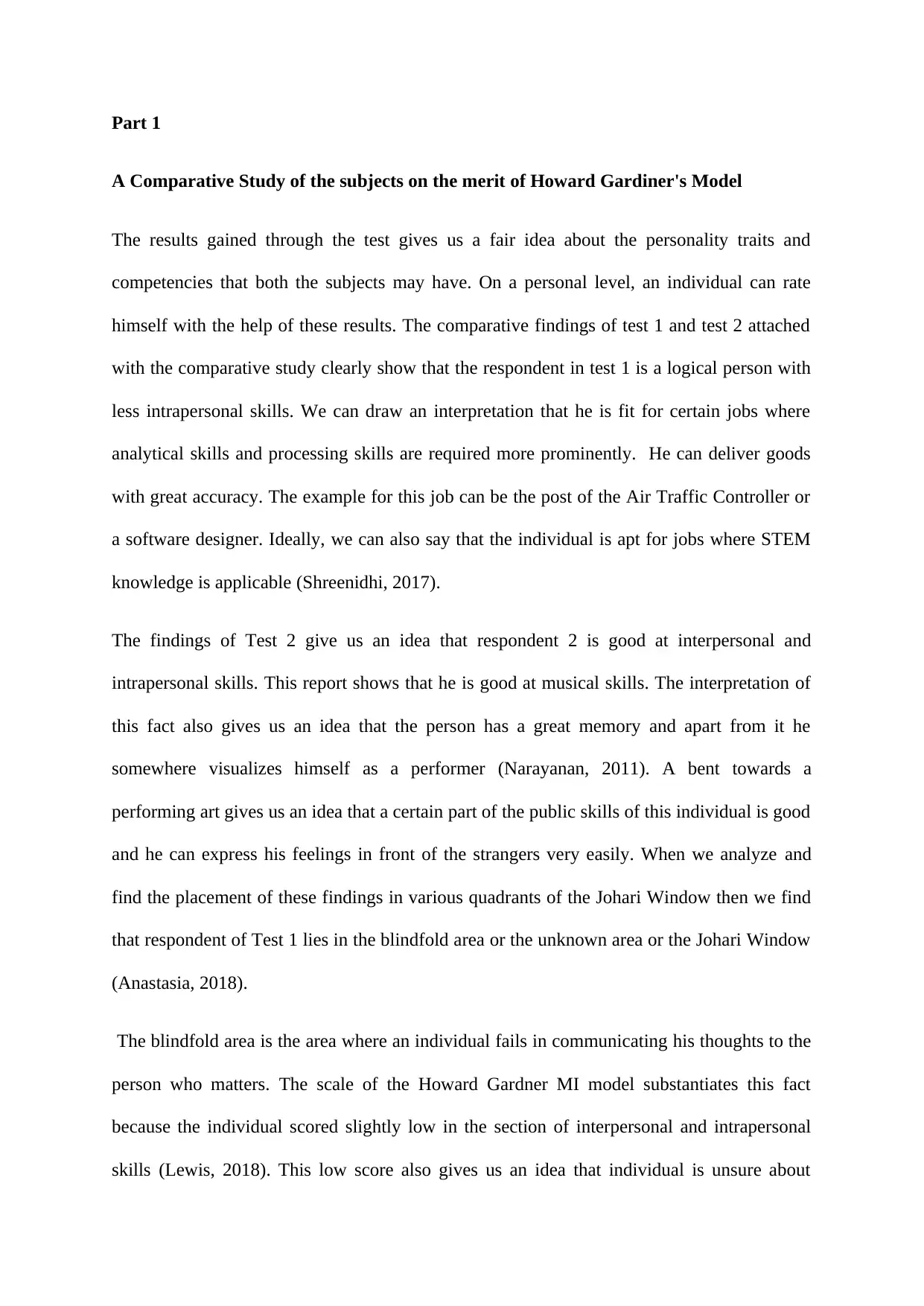
Part 1
A Comparative Study of the subjects on the merit of Howard Gardiner's Model
The results gained through the test gives us a fair idea about the personality traits and
competencies that both the subjects may have. On a personal level, an individual can rate
himself with the help of these results. The comparative findings of test 1 and test 2 attached
with the comparative study clearly show that the respondent in test 1 is a logical person with
less intrapersonal skills. We can draw an interpretation that he is fit for certain jobs where
analytical skills and processing skills are required more prominently. He can deliver goods
with great accuracy. The example for this job can be the post of the Air Traffic Controller or
a software designer. Ideally, we can also say that the individual is apt for jobs where STEM
knowledge is applicable (Shreenidhi, 2017).
The findings of Test 2 give us an idea that respondent 2 is good at interpersonal and
intrapersonal skills. This report shows that he is good at musical skills. The interpretation of
this fact also gives us an idea that the person has a great memory and apart from it he
somewhere visualizes himself as a performer (Narayanan, 2011). A bent towards a
performing art gives us an idea that a certain part of the public skills of this individual is good
and he can express his feelings in front of the strangers very easily. When we analyze and
find the placement of these findings in various quadrants of the Johari Window then we find
that respondent of Test 1 lies in the blindfold area or the unknown area or the Johari Window
(Anastasia, 2018).
The blindfold area is the area where an individual fails in communicating his thoughts to the
person who matters. The scale of the Howard Gardner MI model substantiates this fact
because the individual scored slightly low in the section of interpersonal and intrapersonal
skills (Lewis, 2018). This low score also gives us an idea that individual is unsure about
A Comparative Study of the subjects on the merit of Howard Gardiner's Model
The results gained through the test gives us a fair idea about the personality traits and
competencies that both the subjects may have. On a personal level, an individual can rate
himself with the help of these results. The comparative findings of test 1 and test 2 attached
with the comparative study clearly show that the respondent in test 1 is a logical person with
less intrapersonal skills. We can draw an interpretation that he is fit for certain jobs where
analytical skills and processing skills are required more prominently. He can deliver goods
with great accuracy. The example for this job can be the post of the Air Traffic Controller or
a software designer. Ideally, we can also say that the individual is apt for jobs where STEM
knowledge is applicable (Shreenidhi, 2017).
The findings of Test 2 give us an idea that respondent 2 is good at interpersonal and
intrapersonal skills. This report shows that he is good at musical skills. The interpretation of
this fact also gives us an idea that the person has a great memory and apart from it he
somewhere visualizes himself as a performer (Narayanan, 2011). A bent towards a
performing art gives us an idea that a certain part of the public skills of this individual is good
and he can express his feelings in front of the strangers very easily. When we analyze and
find the placement of these findings in various quadrants of the Johari Window then we find
that respondent of Test 1 lies in the blindfold area or the unknown area or the Johari Window
(Anastasia, 2018).
The blindfold area is the area where an individual fails in communicating his thoughts to the
person who matters. The scale of the Howard Gardner MI model substantiates this fact
because the individual scored slightly low in the section of interpersonal and intrapersonal
skills (Lewis, 2018). This low score also gives us an idea that individual is unsure about
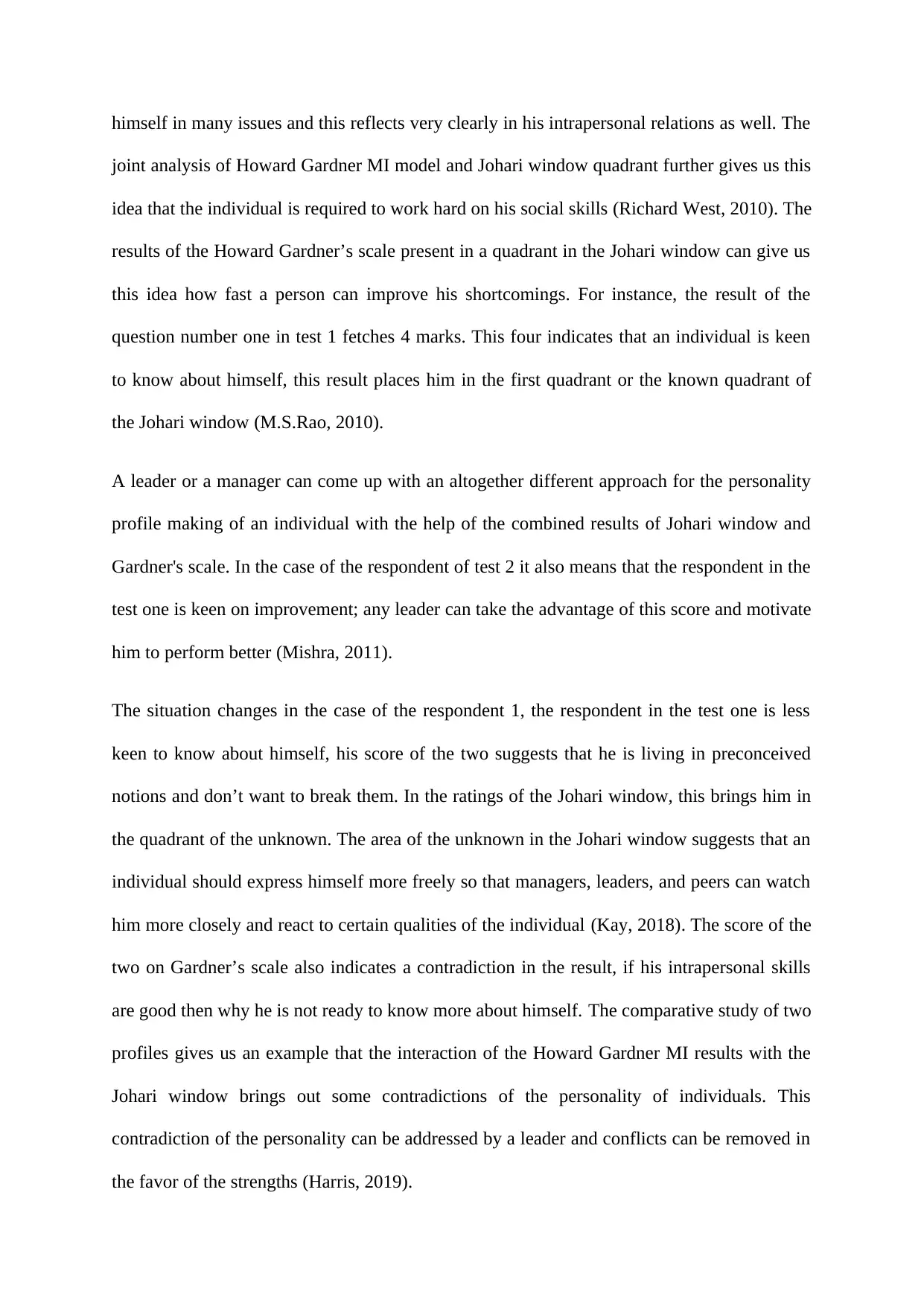
himself in many issues and this reflects very clearly in his intrapersonal relations as well. The
joint analysis of Howard Gardner MI model and Johari window quadrant further gives us this
idea that the individual is required to work hard on his social skills (Richard West, 2010). The
results of the Howard Gardner’s scale present in a quadrant in the Johari window can give us
this idea how fast a person can improve his shortcomings. For instance, the result of the
question number one in test 1 fetches 4 marks. This four indicates that an individual is keen
to know about himself, this result places him in the first quadrant or the known quadrant of
the Johari window (M.S.Rao, 2010).
A leader or a manager can come up with an altogether different approach for the personality
profile making of an individual with the help of the combined results of Johari window and
Gardner's scale. In the case of the respondent of test 2 it also means that the respondent in the
test one is keen on improvement; any leader can take the advantage of this score and motivate
him to perform better (Mishra, 2011).
The situation changes in the case of the respondent 1, the respondent in the test one is less
keen to know about himself, his score of the two suggests that he is living in preconceived
notions and don’t want to break them. In the ratings of the Johari window, this brings him in
the quadrant of the unknown. The area of the unknown in the Johari window suggests that an
individual should express himself more freely so that managers, leaders, and peers can watch
him more closely and react to certain qualities of the individual (Kay, 2018). The score of the
two on Gardner’s scale also indicates a contradiction in the result, if his intrapersonal skills
are good then why he is not ready to know more about himself. The comparative study of two
profiles gives us an example that the interaction of the Howard Gardner MI results with the
Johari window brings out some contradictions of the personality of individuals. This
contradiction of the personality can be addressed by a leader and conflicts can be removed in
the favor of the strengths (Harris, 2019).
joint analysis of Howard Gardner MI model and Johari window quadrant further gives us this
idea that the individual is required to work hard on his social skills (Richard West, 2010). The
results of the Howard Gardner’s scale present in a quadrant in the Johari window can give us
this idea how fast a person can improve his shortcomings. For instance, the result of the
question number one in test 1 fetches 4 marks. This four indicates that an individual is keen
to know about himself, this result places him in the first quadrant or the known quadrant of
the Johari window (M.S.Rao, 2010).
A leader or a manager can come up with an altogether different approach for the personality
profile making of an individual with the help of the combined results of Johari window and
Gardner's scale. In the case of the respondent of test 2 it also means that the respondent in the
test one is keen on improvement; any leader can take the advantage of this score and motivate
him to perform better (Mishra, 2011).
The situation changes in the case of the respondent 1, the respondent in the test one is less
keen to know about himself, his score of the two suggests that he is living in preconceived
notions and don’t want to break them. In the ratings of the Johari window, this brings him in
the quadrant of the unknown. The area of the unknown in the Johari window suggests that an
individual should express himself more freely so that managers, leaders, and peers can watch
him more closely and react to certain qualities of the individual (Kay, 2018). The score of the
two on Gardner’s scale also indicates a contradiction in the result, if his intrapersonal skills
are good then why he is not ready to know more about himself. The comparative study of two
profiles gives us an example that the interaction of the Howard Gardner MI results with the
Johari window brings out some contradictions of the personality of individuals. This
contradiction of the personality can be addressed by a leader and conflicts can be removed in
the favor of the strengths (Harris, 2019).
⊘ This is a preview!⊘
Do you want full access?
Subscribe today to unlock all pages.

Trusted by 1+ million students worldwide
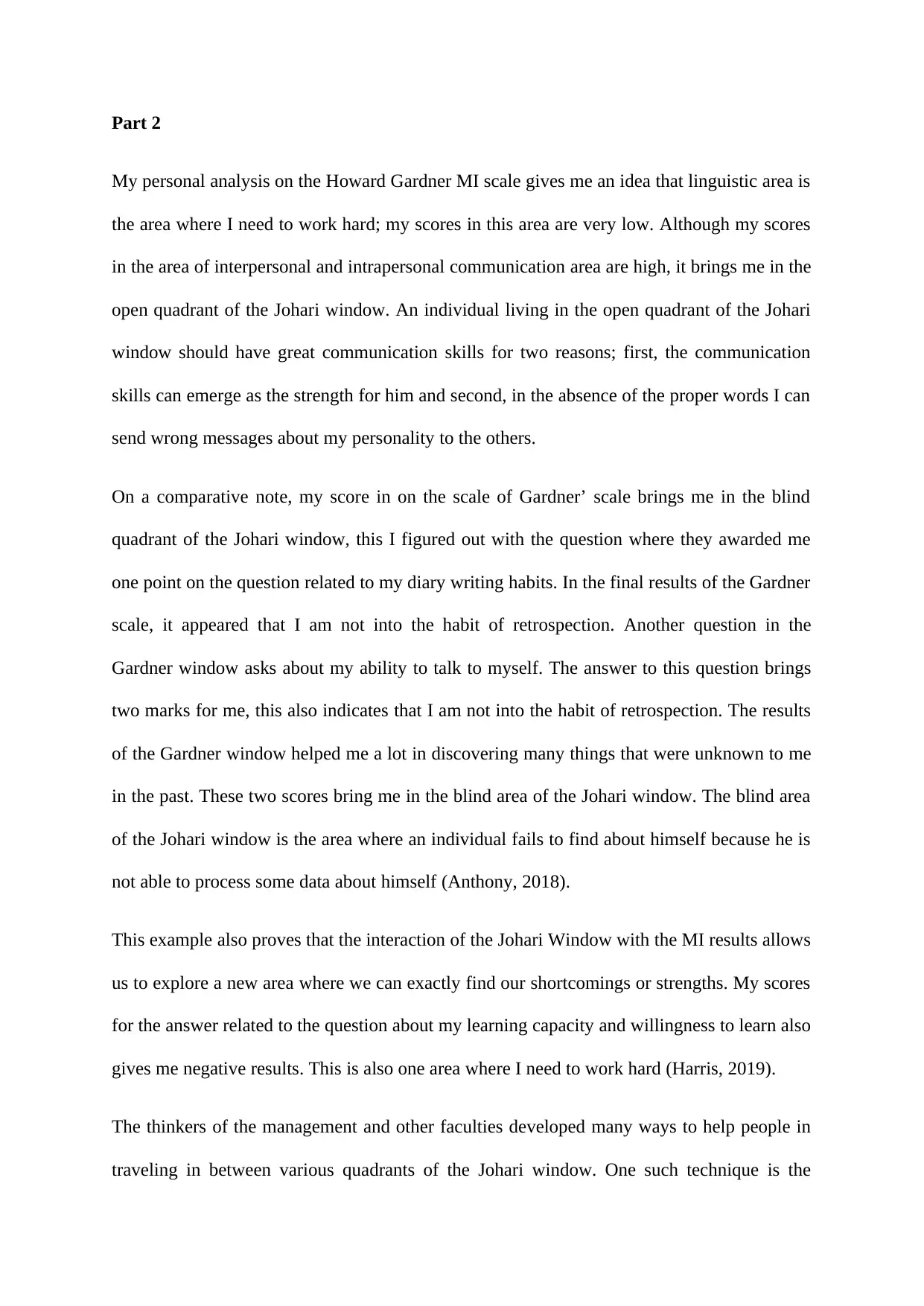
Part 2
My personal analysis on the Howard Gardner MI scale gives me an idea that linguistic area is
the area where I need to work hard; my scores in this area are very low. Although my scores
in the area of interpersonal and intrapersonal communication area are high, it brings me in the
open quadrant of the Johari window. An individual living in the open quadrant of the Johari
window should have great communication skills for two reasons; first, the communication
skills can emerge as the strength for him and second, in the absence of the proper words I can
send wrong messages about my personality to the others.
On a comparative note, my score in on the scale of Gardner’ scale brings me in the blind
quadrant of the Johari window, this I figured out with the question where they awarded me
one point on the question related to my diary writing habits. In the final results of the Gardner
scale, it appeared that I am not into the habit of retrospection. Another question in the
Gardner window asks about my ability to talk to myself. The answer to this question brings
two marks for me, this also indicates that I am not into the habit of retrospection. The results
of the Gardner window helped me a lot in discovering many things that were unknown to me
in the past. These two scores bring me in the blind area of the Johari window. The blind area
of the Johari window is the area where an individual fails to find about himself because he is
not able to process some data about himself (Anthony, 2018).
This example also proves that the interaction of the Johari Window with the MI results allows
us to explore a new area where we can exactly find our shortcomings or strengths. My scores
for the answer related to the question about my learning capacity and willingness to learn also
gives me negative results. This is also one area where I need to work hard (Harris, 2019).
The thinkers of the management and other faculties developed many ways to help people in
traveling in between various quadrants of the Johari window. One such technique is the
My personal analysis on the Howard Gardner MI scale gives me an idea that linguistic area is
the area where I need to work hard; my scores in this area are very low. Although my scores
in the area of interpersonal and intrapersonal communication area are high, it brings me in the
open quadrant of the Johari window. An individual living in the open quadrant of the Johari
window should have great communication skills for two reasons; first, the communication
skills can emerge as the strength for him and second, in the absence of the proper words I can
send wrong messages about my personality to the others.
On a comparative note, my score in on the scale of Gardner’ scale brings me in the blind
quadrant of the Johari window, this I figured out with the question where they awarded me
one point on the question related to my diary writing habits. In the final results of the Gardner
scale, it appeared that I am not into the habit of retrospection. Another question in the
Gardner window asks about my ability to talk to myself. The answer to this question brings
two marks for me, this also indicates that I am not into the habit of retrospection. The results
of the Gardner window helped me a lot in discovering many things that were unknown to me
in the past. These two scores bring me in the blind area of the Johari window. The blind area
of the Johari window is the area where an individual fails to find about himself because he is
not able to process some data about himself (Anthony, 2018).
This example also proves that the interaction of the Johari Window with the MI results allows
us to explore a new area where we can exactly find our shortcomings or strengths. My scores
for the answer related to the question about my learning capacity and willingness to learn also
gives me negative results. This is also one area where I need to work hard (Harris, 2019).
The thinkers of the management and other faculties developed many ways to help people in
traveling in between various quadrants of the Johari window. One such technique is the
Paraphrase This Document
Need a fresh take? Get an instant paraphrase of this document with our AI Paraphraser
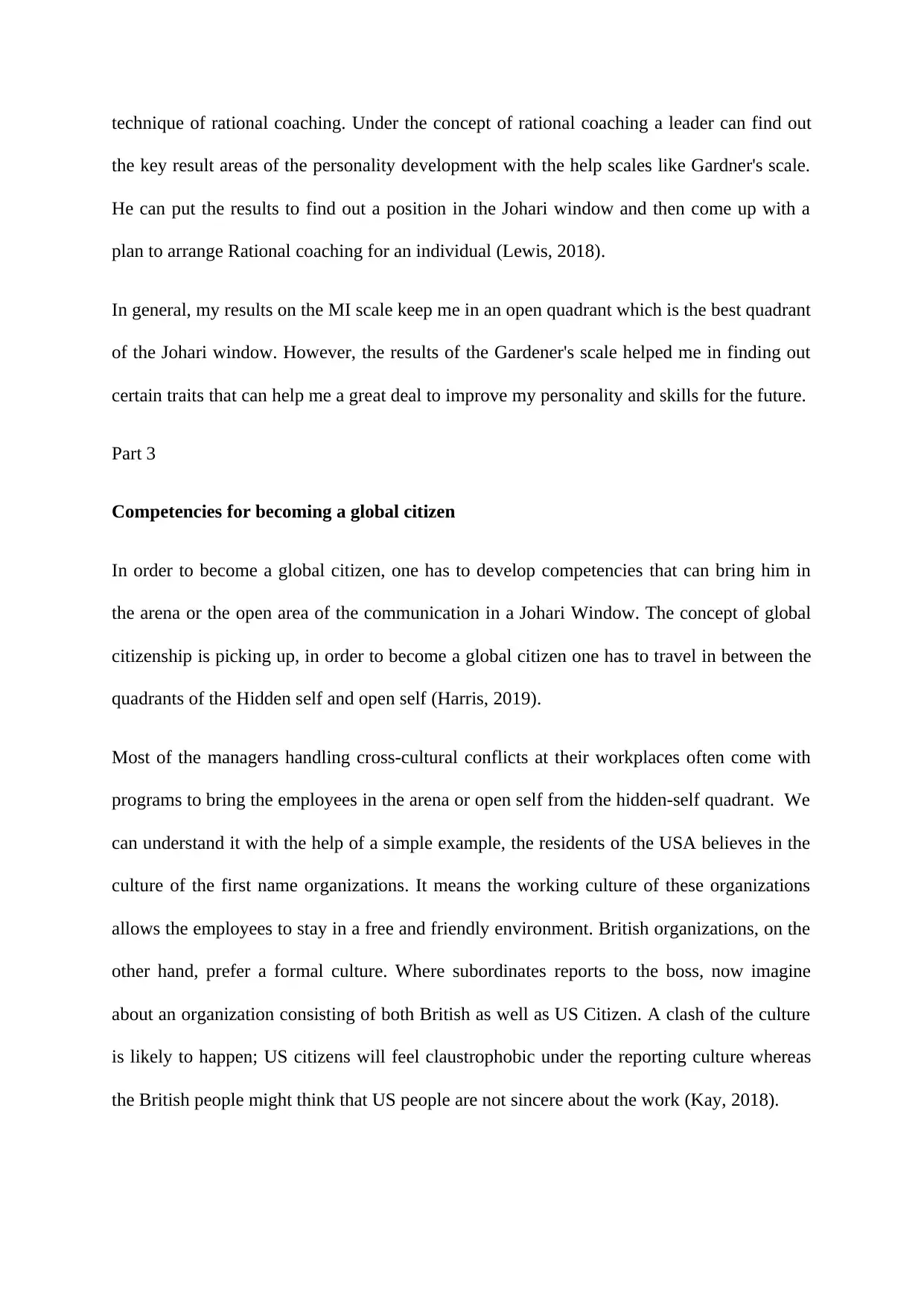
technique of rational coaching. Under the concept of rational coaching a leader can find out
the key result areas of the personality development with the help scales like Gardner's scale.
He can put the results to find out a position in the Johari window and then come up with a
plan to arrange Rational coaching for an individual (Lewis, 2018).
In general, my results on the MI scale keep me in an open quadrant which is the best quadrant
of the Johari window. However, the results of the Gardener's scale helped me in finding out
certain traits that can help me a great deal to improve my personality and skills for the future.
Part 3
Competencies for becoming a global citizen
In order to become a global citizen, one has to develop competencies that can bring him in
the arena or the open area of the communication in a Johari Window. The concept of global
citizenship is picking up, in order to become a global citizen one has to travel in between the
quadrants of the Hidden self and open self (Harris, 2019).
Most of the managers handling cross-cultural conflicts at their workplaces often come with
programs to bring the employees in the arena or open self from the hidden-self quadrant. We
can understand it with the help of a simple example, the residents of the USA believes in the
culture of the first name organizations. It means the working culture of these organizations
allows the employees to stay in a free and friendly environment. British organizations, on the
other hand, prefer a formal culture. Where subordinates reports to the boss, now imagine
about an organization consisting of both British as well as US Citizen. A clash of the culture
is likely to happen; US citizens will feel claustrophobic under the reporting culture whereas
the British people might think that US people are not sincere about the work (Kay, 2018).
the key result areas of the personality development with the help scales like Gardner's scale.
He can put the results to find out a position in the Johari window and then come up with a
plan to arrange Rational coaching for an individual (Lewis, 2018).
In general, my results on the MI scale keep me in an open quadrant which is the best quadrant
of the Johari window. However, the results of the Gardener's scale helped me in finding out
certain traits that can help me a great deal to improve my personality and skills for the future.
Part 3
Competencies for becoming a global citizen
In order to become a global citizen, one has to develop competencies that can bring him in
the arena or the open area of the communication in a Johari Window. The concept of global
citizenship is picking up, in order to become a global citizen one has to travel in between the
quadrants of the Hidden self and open self (Harris, 2019).
Most of the managers handling cross-cultural conflicts at their workplaces often come with
programs to bring the employees in the arena or open self from the hidden-self quadrant. We
can understand it with the help of a simple example, the residents of the USA believes in the
culture of the first name organizations. It means the working culture of these organizations
allows the employees to stay in a free and friendly environment. British organizations, on the
other hand, prefer a formal culture. Where subordinates reports to the boss, now imagine
about an organization consisting of both British as well as US Citizen. A clash of the culture
is likely to happen; US citizens will feel claustrophobic under the reporting culture whereas
the British people might think that US people are not sincere about the work (Kay, 2018).
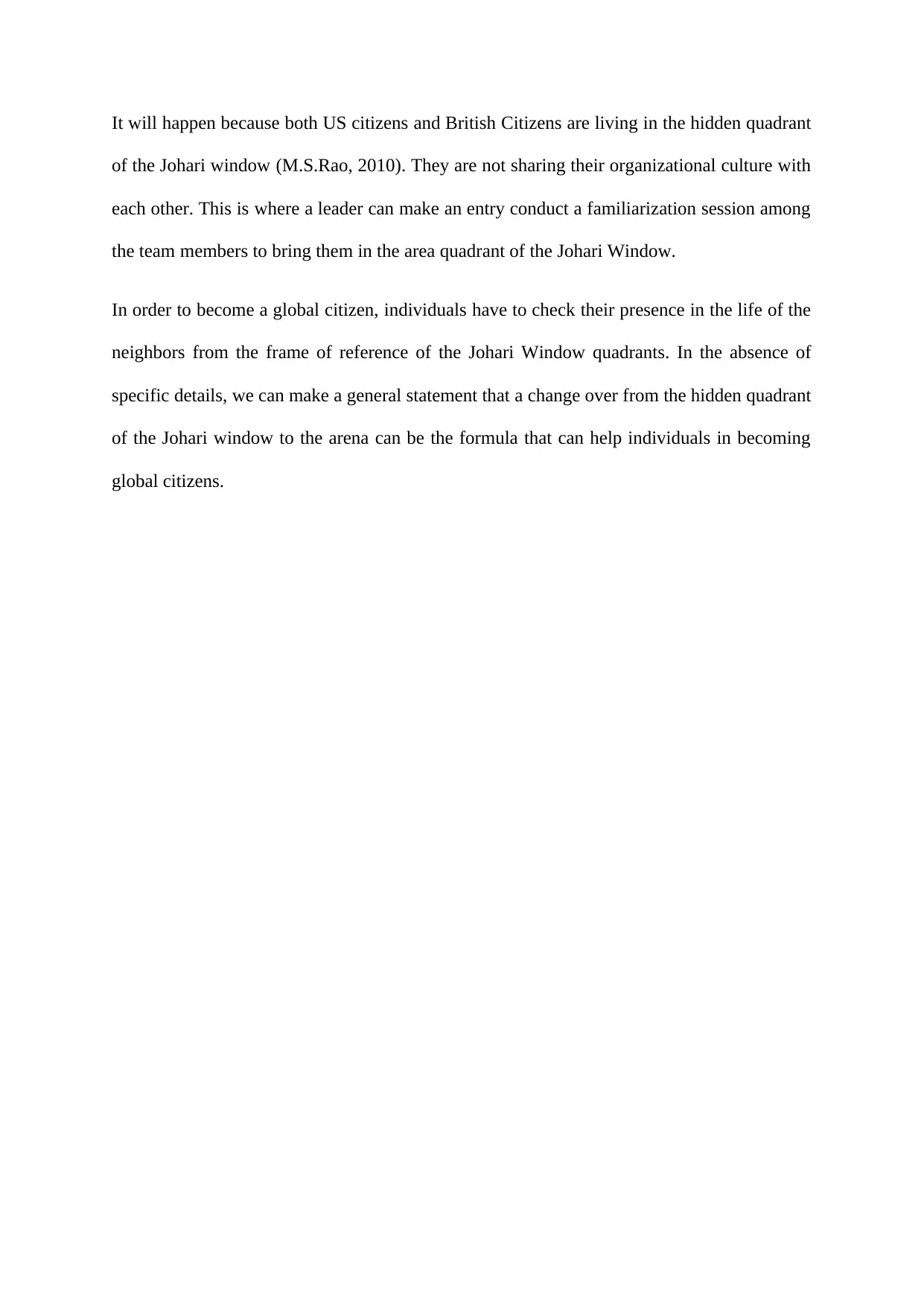
It will happen because both US citizens and British Citizens are living in the hidden quadrant
of the Johari window (M.S.Rao, 2010). They are not sharing their organizational culture with
each other. This is where a leader can make an entry conduct a familiarization session among
the team members to bring them in the area quadrant of the Johari Window.
In order to become a global citizen, individuals have to check their presence in the life of the
neighbors from the frame of reference of the Johari Window quadrants. In the absence of
specific details, we can make a general statement that a change over from the hidden quadrant
of the Johari window to the arena can be the formula that can help individuals in becoming
global citizens.
of the Johari window (M.S.Rao, 2010). They are not sharing their organizational culture with
each other. This is where a leader can make an entry conduct a familiarization session among
the team members to bring them in the area quadrant of the Johari Window.
In order to become a global citizen, individuals have to check their presence in the life of the
neighbors from the frame of reference of the Johari Window quadrants. In the absence of
specific details, we can make a general statement that a change over from the hidden quadrant
of the Johari window to the arena can be the formula that can help individuals in becoming
global citizens.
⊘ This is a preview!⊘
Do you want full access?
Subscribe today to unlock all pages.

Trusted by 1+ million students worldwide
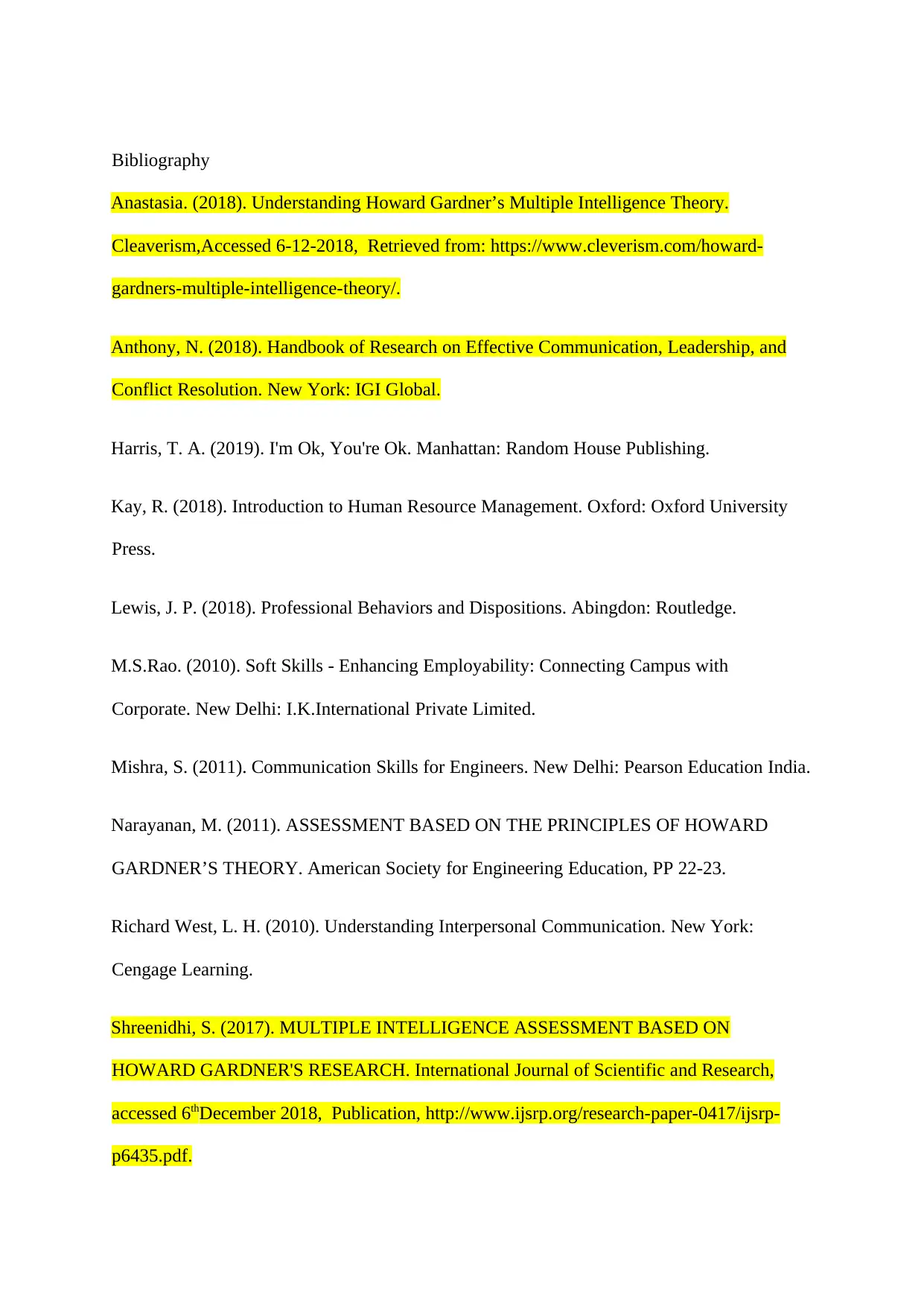
Bibliography
Anastasia. (2018). Understanding Howard Gardner’s Multiple Intelligence Theory.
Cleaverism,Accessed 6-12-2018, Retrieved from: https://www.cleverism.com/howard-
gardners-multiple-intelligence-theory/.
Anthony, N. (2018). Handbook of Research on Effective Communication, Leadership, and
Conflict Resolution. New York: IGI Global.
Harris, T. A. (2019). I'm Ok, You're Ok. Manhattan: Random House Publishing.
Kay, R. (2018). Introduction to Human Resource Management. Oxford: Oxford University
Press.
Lewis, J. P. (2018). Professional Behaviors and Dispositions. Abingdon: Routledge.
M.S.Rao. (2010). Soft Skills - Enhancing Employability: Connecting Campus with
Corporate. New Delhi: I.K.International Private Limited.
Mishra, S. (2011). Communication Skills for Engineers. New Delhi: Pearson Education India.
Narayanan, M. (2011). ASSESSMENT BASED ON THE PRINCIPLES OF HOWARD
GARDNER’S THEORY. American Society for Engineering Education, PP 22-23.
Richard West, L. H. (2010). Understanding Interpersonal Communication. New York:
Cengage Learning.
Shreenidhi, S. (2017). MULTIPLE INTELLIGENCE ASSESSMENT BASED ON
HOWARD GARDNER'S RESEARCH. International Journal of Scientific and Research,
accessed 6thDecember 2018, Publication, http://www.ijsrp.org/research-paper-0417/ijsrp-
p6435.pdf.
Anastasia. (2018). Understanding Howard Gardner’s Multiple Intelligence Theory.
Cleaverism,Accessed 6-12-2018, Retrieved from: https://www.cleverism.com/howard-
gardners-multiple-intelligence-theory/.
Anthony, N. (2018). Handbook of Research on Effective Communication, Leadership, and
Conflict Resolution. New York: IGI Global.
Harris, T. A. (2019). I'm Ok, You're Ok. Manhattan: Random House Publishing.
Kay, R. (2018). Introduction to Human Resource Management. Oxford: Oxford University
Press.
Lewis, J. P. (2018). Professional Behaviors and Dispositions. Abingdon: Routledge.
M.S.Rao. (2010). Soft Skills - Enhancing Employability: Connecting Campus with
Corporate. New Delhi: I.K.International Private Limited.
Mishra, S. (2011). Communication Skills for Engineers. New Delhi: Pearson Education India.
Narayanan, M. (2011). ASSESSMENT BASED ON THE PRINCIPLES OF HOWARD
GARDNER’S THEORY. American Society for Engineering Education, PP 22-23.
Richard West, L. H. (2010). Understanding Interpersonal Communication. New York:
Cengage Learning.
Shreenidhi, S. (2017). MULTIPLE INTELLIGENCE ASSESSMENT BASED ON
HOWARD GARDNER'S RESEARCH. International Journal of Scientific and Research,
accessed 6thDecember 2018, Publication, http://www.ijsrp.org/research-paper-0417/ijsrp-
p6435.pdf.
Paraphrase This Document
Need a fresh take? Get an instant paraphrase of this document with our AI Paraphraser

1 out of 8
Related Documents
Your All-in-One AI-Powered Toolkit for Academic Success.
+13062052269
info@desklib.com
Available 24*7 on WhatsApp / Email
![[object Object]](/_next/static/media/star-bottom.7253800d.svg)
Unlock your academic potential
Copyright © 2020–2025 A2Z Services. All Rights Reserved. Developed and managed by ZUCOL.



